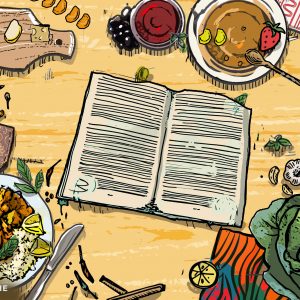Book Review | In Bibi’s Kitchen
In Hawa Hassan’s cookbook, elderly women from Somalia to Cape Town, whose voices and food contributions are often overlooked, take centre stage. Dishes prepared with love dominate the pages.
Author:
14 January 2021

Somali chef Hawa Hassan had to pitch her cookbook idea continuously in the face of much rejection. After running her food business for a few years, she wanted to create a cookbook of the women she couldn’t find in the media, the elderly African women who are central to her world. In a publishing industry that repeatedly excludes African cuisine, she was told that “Africa is hard to sell”.
She finally got a yes, however. And Penguin Random House published her book – In Bibi’s Kitchen, co-written with food writer Julia Turshen – towards the end of last year.
Bibi, meaning grandmother in Kiswahili, represents the heart of the book. As the subtitle says, it contains “the recipes and stories of grandmothers from the eight African countries that touch the Indian Ocean”. With a chapter on each, starting in the north and working south, the countries include Eritrea, Somalia, Kenya, Tanzania, Mozambique, South Africa, Madagascar and the Comoro Islands.
In an industry that often undervalues elderly women and deems male chefs the chief innovators, this book consciously centres the voices of grandmothers. It features the story of each woman in her own words. Hassan is explicit in her intentions. She wanted to highlight the women who are seldom or never invited to share their stories in the culinary industry. They are elderly women, often Black. This is ironic, she says in an interview on the Thrillist website, “given that they have the best stories to tell”.
Unlike most cookbooks, this one isn’t trying to be trendy and new. “It’s about what’s here to stay,” says Hassan. It’s documenting culture and the role that grandmothers play in shaping it. They define and uphold their communities, while keeping everyone fed.
‘Food is like language’
“Food is… just like language,” Ma Khanyisa tells Hassan from her home in Cape Town, in one of the interviews in the book. “For me, stopping traditions would almost be like throwing my culture away.” As food writer Osayi Endolyn says, “The seat of power in food – its soul and expertise – has always begun at home, at the hands of skilled women in their kitchens.”
When it comes to the recipes, almost all the women say they chose ones that are easier to make and comforting and nutritious. Reflected in their choices is the importance of nourishment in food, accessibility of ingredients and practicality in preparation.
And while many women speak of the traditional way a dish is made, some share the ways they’ve altered a recipe to their taste. They show the limitations of using one recipe as the measure of an entire tradition, when there are so many differences informed not only by region but also by the specific tastes of families or individual people’s styles.
Related article:
Reviewing the book in food newsletter Vittles, Fozia Ismail writes: “It is the first time I have seen people like my mother reflected so accurately in a cookbook. Unlike so many cookbooks, which typically extract cooking knowledge and techniques whilst erasing the very experts in the Global South, this is a book that is rooted in a politics of care towards the bibis, shining a light on the way East African women, whose lives may have been uprooted through migration, have held families and communities together through food.”
As a fellow Somali food writer, Ismail is always on the search for recipes and food from the country. Somali cooking does not feature much in many cookbooks. It is, in fact, extremely difficult to find. Somalia is often associated with famine and despair, and its food hasn’t been portrayed much better. Hassan and Ismail’s writing on the beauty and richness of Somali food might begin to change this.
The power of In Bibi’s Kitchen comes from hearing straight from the grandmothers. They are proud of their food and recipes, and it is with lightness and joy that they talk about it.
Ismail also touches on the erasure of African people in cookbooks and food writing in general. It is rare to see the hands and bodies behind the food spotlighted in cookbooks. “Yet the joy, warmth and familiarity that emanates from the book is wonderful,” she writes. “The cover, with ochre-tipped fingers that have been blessed by henna delicately breaking open cardamom shells, is a familiar and welcome sight on this grey lockdown day. These could be my mother’s hands.”
More than just recipes
In Bibi’s Kitchen “fills a deep and vast void in the contemporary cookbook market”, writes Hassan in the book’s introduction. “There are barely any cookbooks published by American publishing houses that feature African food.” She adds that Africa is still treated as a monolith, and is quick to state that she doesn’t speak for Africa, only part of the continent. It is Hassan’s hope that one day there will be so many African voices that the differences and depths of cuisines and perspectives will come to be known.
While it’s a cookbook filled with delicious recipes, they do so much more, telling the history of the places from which these recipes originate. The book features discussions about the lasting effects of colonialism and how it has affected the way people eat. And how war, migration and displacement have reshaped ideas of “home”.
Women who have had to leave their countries for various reasons use food to remind them of home while teaching their children about where they come from. In the case of Ma Sahra in the Somalia chapter, she hasn’t moved from her birthplace but the border has shifted. The Somalian territory that was once her home is now part of Kenya.
Related article:
Hassan’s story is remarkable, too. Her family fled from civil war in Somalia to a refugee camp in Kenya. She was later sent to the United States as a child, alone because the rest of her family did not receive the documentation needed. She grew up with Eritrean and Ethiopian families and became much more familiar with their food.
When she was older and able to reunite with her family, reconnecting with Somali food brought back her early childhood memories. She would be so immersed in the food that eventually she carved a career out of it. She began with a Somali condiment business called Basbaas Foods. Inspired by her experiences, she branched into other food traditions as well, and that has been her direction since.
As one works through the chapters about family, food and history, a unique picture surfaces about the story of southern and East African women, at home in their communities and as immigrants, in Africa and the US.
Legacy of the Indian Ocean
The eight countries that make up the chapters of the book are connected through historical Indian Ocean trade routes before, during and after colonialism. What marks them now is mostly their spice-rich cuisines. Hassan, being so familiar with East African food, wanted to do a regional African cookbook. Having lived in Kenya and South Africa, she saw links in southern and East African cuisine, in the spices and techniques of these places, and in the spirit of the aunties and grandmothers she met there.
The connecting thread was the Indian Ocean and the spice trade that this ocean facilitated. While much of this history carries the brutality of colonialism, slavery and indentured labour, there also existed the trading and sharing of food knowledge and food ways outside of that brutality. These recipes tell a more complete story, one of creativity, resilience and care.
Related article:
Rather than tying the entire continent together in a simplistic manner, Hassan wanted to zoom in on specific places to show the nuanced differences and tell a more specific food story. Much of the book is a collaboration over time, countries and continents. It illuminates connection without oversimplifying the unique history of each place.
Somali photographer Khadija Farah took the photos for the book. Having someone from the regional culture – who photographs the food as it is, without the exaggeration or distortion that exemplifies the Western gaze – is rare in cookbook writing and photography.
While Hassan has wanted to tell the story of her culture and its people for so long, it comes at a price. In such an exclusive industry, she is one of only a few writing about African cuisine. “The truth is that it’s too much of a burden for one person to carry. That’s why it would be beneficial if more African people were telling these stories, so that the weight of it isn’t just on one of us. One of us can’t speak for all of Nigeria. One of us can’t speak for all of East Africa,” she says in the Thrillist interview.
While it may seem like a distant reality, maybe one day bookshelves will be full of cookbooks that not only feature national cuisines but also more local and regional cuisines, and their histories, the way we see cookbooks about Tuscan staples or food from Provence, France. With the increase in African cookbooks in South Africa, more and more people are eager to cook and try African food. Hopefully this will lead to an end to the gatekeeping that hinders the publication of such books.



